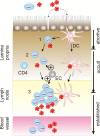HIV vaccine development in the aftermath of the STEP study: re-focus on occult HIV infection?
- PMID: 18769723
- PMCID: PMC2517652
- DOI: 10.1371/journal.ppat.1000114
HIV vaccine development in the aftermath of the STEP study: re-focus on occult HIV infection?
Conflict of interest statement
The authors have declared that no competing interests exist.
Figures

References
-
- Flynn NM, Forthal DN, Harro CD, Judson FN, Mayer KH, Para MF. Placebo-controlled phase 3 trial of a recombinant glycoprotein 120 vaccine to prevent HIV-1 infection. J Infect Dis. 2005;191:654–665. - PubMed
-
- Karlsson Hedestam GB, Fouchier RA, Phogat S, Burton DR, Sodroski J, Wyatt RT. The challenges of eliciting neutralizing antibodies to HIV-1 and to influenza virus. Nat Rev Microbiol. 2008;6:143–155. - PubMed
-
- Robertson M, Casimiro DR, De Rosa S, Dubey S, Kierstead L, McElrath J. Immunological Characterization of Subjects from the STEP Study: A Phase IIB Test-of-Concept Trial of the MRKAd5 HIV-1 Gag/Pol/Nef Trivalent Vaccine 2008
-
- Robertson M, Mehrotra D, Fitzgerald D, Duerr A, Casimiro DR, McElrath J, Lawrence D, Buchbinder S. Efficacy Results from the STEP Study (Merck V520 Protocol 023/HVTN 502): A Phase II Test-of-Concept Trial of the MRKAd5 HIV-1 Gag/Pol/Nef Trivalent Vaccine 2008
-
- Buchbinder S. STEP Trial: Exploring hypotheses for differential HIV acquisition rates. 2008. HVTN Full Group Meeting November 7, 2007.
Publication types
MeSH terms
Substances
LinkOut - more resources
Full Text Sources
Medical

